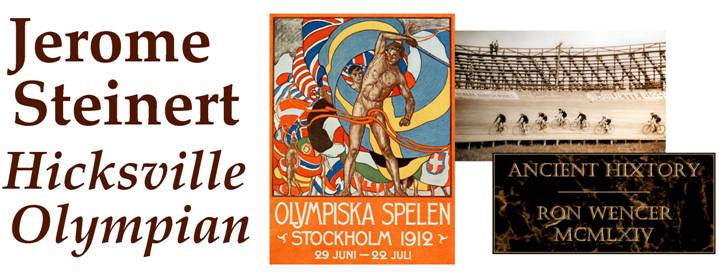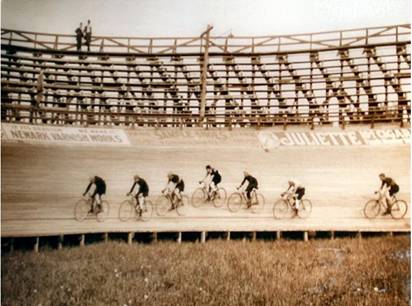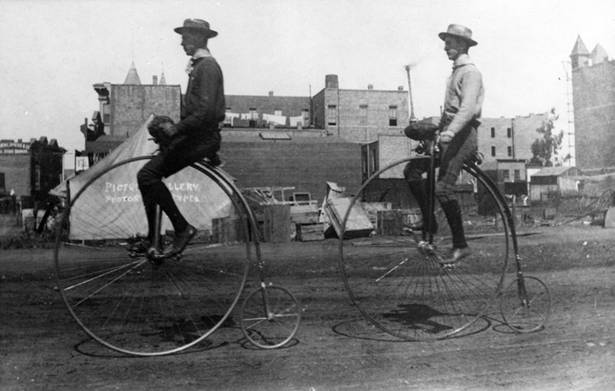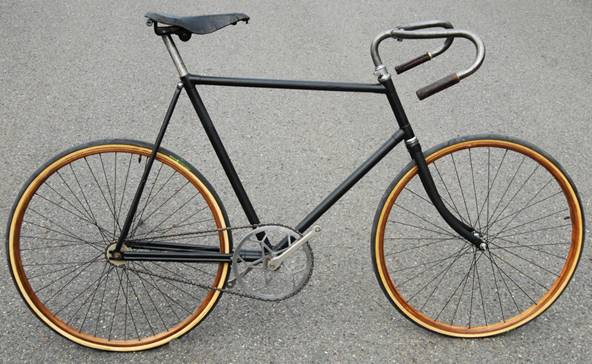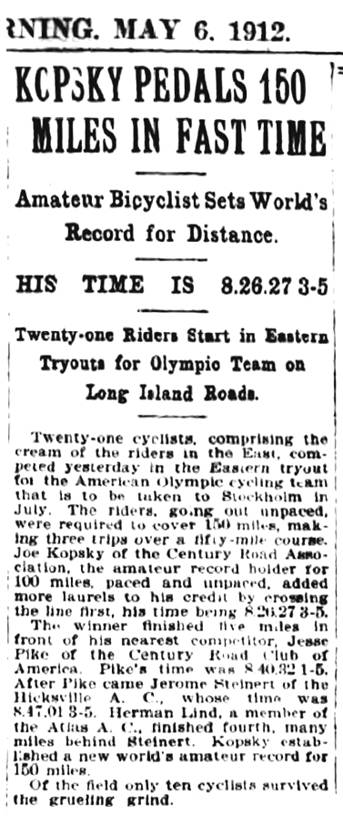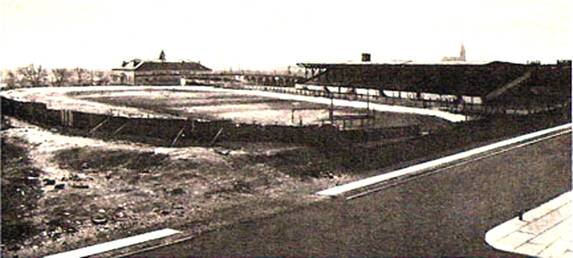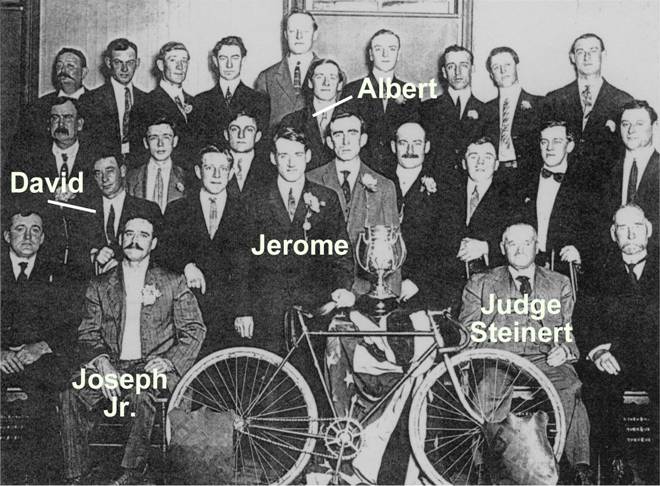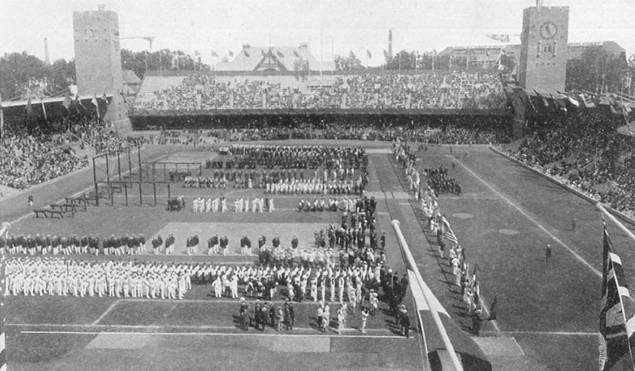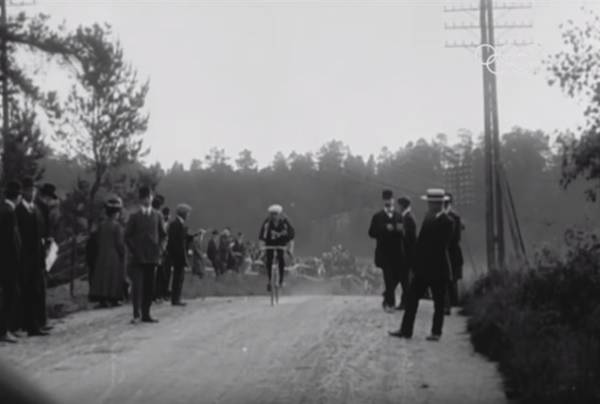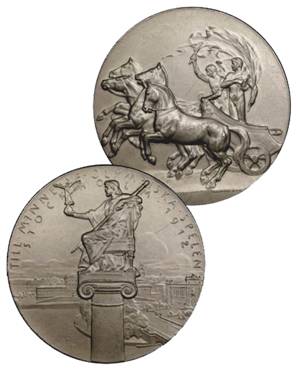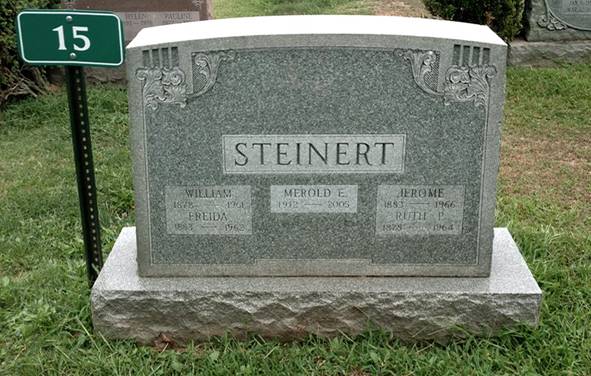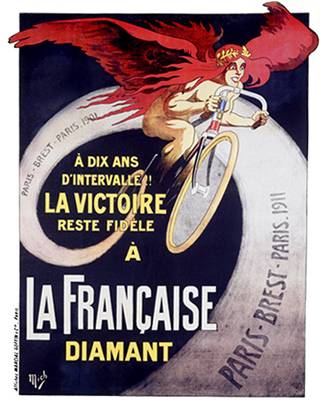|
SEPTEMBER
2018 |
|||||||||||
|
On a Sunday morning in May, 1912,
onlookers cheered as a local cyclist sped through Pete was the seventh of nine children.
He was born to Agnes and Joseph Steinert in Hicksville late in
1883, not long after the Steinert family moved east from the
Two
Clarifications
These
illustrations, respectively from the 1910 Another
point to clarify is that, as implied by the above list of offices held
by Judge Steinert, Hicksville once was part of Early
Racing Career It is not clear when Pete Steinert
first entered an organized cycling race.
The earliest report of formal competition which I have found
refers to an event held on May 30th, 1901, when he was 17
years old. He probably
already had racing experience, for on that day he was victorious in two
races, one of them ten miles long. As
time went by, Pete showed confidence in his riding, competing on tracks,
in road races, in hill climbs - and even in
something described as a "Liverpool Steeplechase."
Although Long Island offered opportunities in many places (e.g.,
Any joy was short-lived,
however. A month later,
Steinert was on the same track for a regional championship.
During one race, he was riding part-way up the banked track,
following close behind Clarence Carmen, the national champion.
Suddenly, Carmen tried to dart to the inside, between two
cyclists. He struck one of
their wheels and went down. Pete
could not help but crash over him; both men were seriously injured.
One of Steinert's collarbones was broken into three pieces.
It was time to convalesce. Not
Today's Bicycles Early bicycles had been too primitive
to race. The wooden bone shakers of the 1840s were slow and awkward, even tortuous to
ride. By the 1870s, things
had evolved; there were new bicycle frames made of metal tubing, wheels
with tensioned wire instead of wooden spokes, and solid rubber tires.
When these things came together, people realized that they had
bicycles which they could race, and they did. Like early airplanes, these bicycles
were not sleek or lean. Indeed,
they looked a bit ridiculous. In
https://commons.wikimedia.org/wiki/File:Pennyfarthing-1886.jpg Why were the front wheels so big?
There were no gears; the rider pedaled a crank that was part of
the front axle. For the ordinary
to go faster than a child's tricycle, the front wheel had to be
larger. To win races, it had
to be MUCH larger, with a diameter of 60" or more.
Ordinaries were fast
(for their time) and they were dangerous.
A fall, or even just climbing off, was risky.
Moreover, there were no brakes.
As with the bicycles used for modern sprints, to slow his
machine, a cyclist resisted the turning of the pedals with his feet and
leg muscles - something which was practically impossible when his legs
were so fully extended as those in the picture above.
To stop quickly, an accomplished "wheelman" leaned forward to
grab the front tire and stop its rotation.
In such a stop, he risked being catapulted over the ordinary's
front wheel, and on the way forward his thighs might be impaled upon the
handlebars. The racers of
the day were not only dashing; they were daring. Around the time that Jerome Steinert
was born, bicycles advanced further.
The advent of the bicycle chain made possible the use of
different-sized gears on a crank and axle, a combination which made huge
wheels obsolete. These
features were combined in what became known as the safety
bicycle. A few years later,
the invention of inflatable tires made cycling even better.
The example below (which is missing its pedals) is a
well-preserved Czech-made safety.
sterba-bike.cz Don't
let the familiar appearance mislead you. These racers did not have
"freewheeling" or "coaster" hubs; the pedals moved whenever the
bicycle did - even in a 150 mile race. In
1912, derailleurs had not yet been perfected, and they were not used in
racing. Before a race began,
a rider either chose a gear for the rear axle, or simply used the same
gear he always used. Whether
racing on level ground, up and down hills, on a wooden track or on a
dirt road, mile after mile he used the same gear. The safety type would never completely go away; year by year, it
gradually evolved. Steinert
doubtlessly pedaled a safety
in his youth, and he certainly raced one.
They were much less risky than ordinaries
- for one thing, you didn't have as far to fall, and a rider might
be able to land on his feet. There
still were no brakes, for in that era, bicycle brakes quickly wore down
tires, and sometimes caused punctures, but at least the strong legs of
the rider were better positioned to use the pedals for slowing his
machine. Of course, having safer
machines only encouraged cyclists to take more chances.
Wheelmen were still dashing and daring. Comeback The next Hicksville
Athletic Club games, in which the A.C. (Steinert was a founding member
when the organization began in 1905) competed against representatives of
other athletic associations, occurred only eight weeks after
Steinert's injury. With
barely time to recover, Pete chose to race.
Although the level of competition probably did not match what he
had faced at Vailsburg, he must have been pleased to win both the
one-half mile and five mile races.
A drawback of relying on
old newspapers for research is that not all of them have survived, and
there are gaps. The extant
newspapers show almost no evidence of Steinert's racing in 1910.
Perhaps he had little time for the sport due to his job (he was
an underwriter for an electric utility).
It seems more likely, however, that he needed a prolonged period
to heal completely, and then to get his body back into racing condition
- which he eventually did. Reports
in two 1911 newspapers indicate that he must have done some racing in
the prior year, for they refer to Pete's having been the 1910 U.S.
National Champion in the quarter-mile.
Continued respect for his cycling was further reinforced in 1911,
by his winning a half-mile race at the 12,500 seat Newark Velodrome,
after which a newspaper reported that Pete Steinert had "regained his
form."
https://thecabe.com/forum/threads/toc-tracks-and-velodromes.125781/ That September, Hicksville
A.C. held a Cycling Carnival
competition, and Steinert had a remarkable day.
He had the fastest absolute time in the five mile handicap; he
took five seconds off the national record for the one-quarter mile, and
he also set a new two mile record, eleven seconds better than the old.
He definitely was back. Making
the Team The modern Olympics had been
instituted in 1896, and as late as 1909, a number of nations still were
uncertain about continuing with them.
The most recent Olympiads had experienced problems: spotty
participation in For the 1912 Olympics, a consensus was
reached that A compromise was reached: there would
be one cycling event at
And so, on the 5th of May,
Pete Steinert and 21 other cyclists (some news reports miscounted them)
assembled at Only ten of the starters finished the
race, and the top competitors among them were excellent:
Within a week, seven comparable races
had been completed across the country.
A news report stated that the top finishers from all eight races
would compete against each other on May 24th in a final
qualification race, in order to determine the members of the Olympic
cycling team. That report
was not exactly correct, however.... Well before the final qualifying race,
newspapers announced that Pete Steinert had been named to the Olympic
cycling team. Apparently,
similar news reports appeared around the country for other competitors.
For the final qualification race, only twelve competitors
assembled at With their departure for
wingedfist.org/Celtic_Park_History.html Two days before the athletes departed
for the Olympics, the Hicksville A.C. honored Steinert, at a dinner at
The opening ceremonies for the 1912
Olympics began late on the morning of July 6th, each
nation's athletes following their country's flag as they marched
into the stadium. With the
entrance of the Japanese team, the games became the first Olympics to
include competitors from five continents.
King Gustav V spoke; he would continue to participate in
ceremonies during the games, personally awarding medals to athletes.
Athletes
Entering (the The cycling race was to be contested
the next day. The
determination of the team medals would be straightforward: the times of
each nation's top four finishers would determine the rankings.
With regard to the official log of the participants, any rider
who crossed the finish line with a time more than 25% above that of the
winner would be deemed to have not finished the race.
The cyclists had been assigned to groups for the staggered start,
with each group departing at a fixed time.
As the first group was to start at 2:00 AM, it is doubtful that
many cyclists lingered at the conclusion of the opening ceremonies. Some motion picture footage of the
race survives. The screen
shot below was taken from https://www.youtube.com/watch?v=f7c7Nka_LHE
It includes about a minute of film clips.
olympic.org 120 cyclists started the race.
Rudolph Lewis, a South African, was the individual winner, having
completed the course in 10:42:39, with an average speed over 199 miles
of more than 18.5 mph. American
Carl Otto Schutte of Kansas City was third at 10:52:87.
Pete Steinert finished at 12:08:13, well behind, but still among
the top half of the starters. The
team winner was From an American perspective, Schutte
was the cycling story of the games.
In the 150 mile qualifier in the heat of
When the ship arrived in Life
After Cycling Soon to turn 29, Pete seemed to leave
cycling competitions behind (at least, his name no longer appeared in
newspapers in that context). Late
in 1913, he married a young Brooklyn woman; they honeymooned in Bermuda,
and settled down in During World War I, he worked in Pete passed away in 1966, a month
before his 83rd birthday.
He was buried in Hicksville's
BillionGraves.com Conclusion Researching Jerome Steinert from old
news reports has been an interesting exercise.
Like today's sports reporters, the newshounds of a century ago
were prone to be overly optimistic or pessimistic.
As noted earlier, facts sometimes gave way to reporters' gut
feelings. All memories can fade, but some grow
with the passage of time. For
example, years after one of Long after his foray to It is easy to call a perennial
champion great, but Steinert was not a perennial champ.
Calling him great, and in fact the greatest of all, while knowing
that he competed in an Olympics without medalling, is not something that
one would do frivolously. It
suggests that although Pete Steinert did not win an overwhelming
collection of medals, championships, and glory, the reporter saw in him
an abundance of character, and the essence of greatness. One suspects that Steinert soon
rebounded from any disappointment which he felt after *** And
to close... A different take on the "Winged
Victory" theme: a c.1912 bicycle advertisement, designed to appeal to
the dashing wheelman
www.OldBike.eu/museum |
